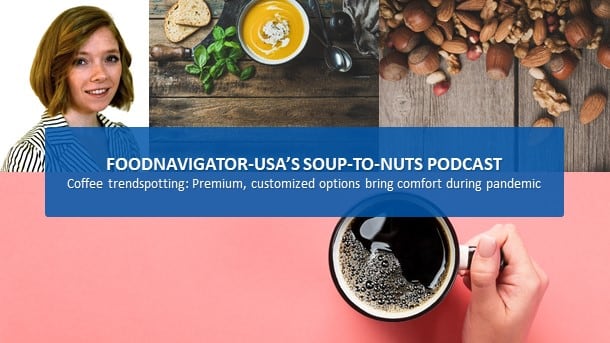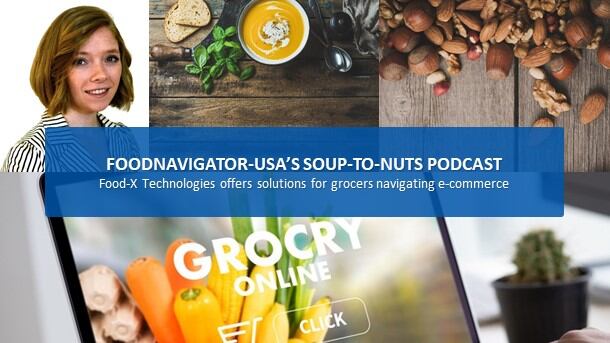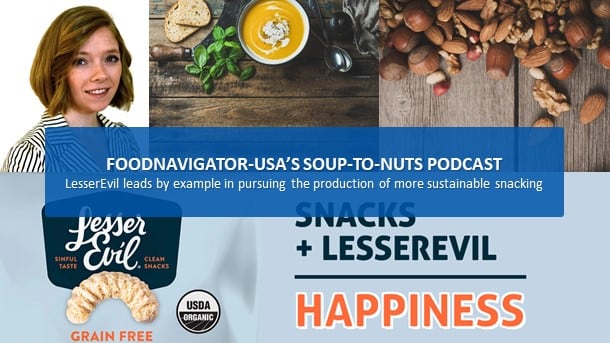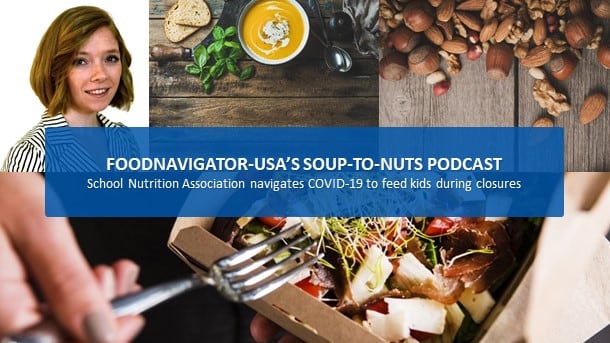Rather, new research from the National Coffee Association reveals that even before COVID-19 landed on US soil, more Americans were reaching for the beverage as a source of energy, comfort and normalcy, as well as a way to socialize and explore new experiences.
This uptick in interest is creating new opportunities for coffee shops and CPG brands that the President and CEO of the National Coffee Association Bill Murray says will help sustain the industry during and after the current pandemic as well as through any longer terms impact of the disease, such as an economic recession.
In this episode of FoodNavigator-USA’s Soup-To-Nuts podcast, Murray shares data from NCA’s massive National Coffee Data Trends report about how consumer interest in coffee is evolving, including who is reaching for coffee, what types of products they prefer, where they are buying it and how this compares to other beverages and past behaviors. He also shares strategies to help foodservice and CPG coffee providers not only survive, but thrive during the current pandemic, as well as where he sees the category going in the longer-term.
[Editor's note: Never miss another episode of FoodNavigator-USA's Soup-To-Nuts podcast -- subscribe today on iTunes.]
A searchable database makes report a treasure trove for industry
Based on a survey of a representational sample of more than 2,800 Americans, NCA’s National Coffee Data Trends report is a virtual treasure trove for industry players looking to meet evolving consumer demands, said Murray.
He explained that while highlights from the report are available in written word, a potentially more useful format is the “mini online database” that NCA makes available, which allows stakeholders to “ask their own questions against the data” and discover which trends are on the rise in their areas or among their target consumer.
For example, he said, “you can look and see what age groups are creating these new opportunities so that you can target your advertising and your marketing,” and you can uncover ways to keep “your business consistent with your business objectives and where the marketing is going.”
So, where is the market going? Well, according to the report, it is going up – both in terms of the number of Americans drinking coffee and the quality of the beans, beverages and experiences they are seeking.
“Sixty two percent of Americans are drinking coffee every day. Seventy percent of Americans drink coffee at least once a week,” which is up on a daily basis about 5% since 2015, Murray said.
Just to put this increase in context with other common beverages, NCA reports that coffee is the United States’ “favorite beverage,” with, as Murray noted, 62% drinking it daily, compared to only 47% who drink tap water daily, 54% who drink bottled water daily and 41% who opt for soft drinks daily.
Who is drinking coffee?
According to Murray, consumers’ love of coffee cuts across generations. But what type of coffee they reach for and where they buy and consume it varies greatly depending on their age.
Specifically, the report found that young consumers aged 18 to 24 years are more than four times more likely to opt for a macchiato than those older than 60 years. Similarly, Americans aged 25 to 39 years are more likely to drink straight espresso than those older than 60 years with 22% of the younger group drinking it at least once a week compared to just 7% of their elders.
Murray attributes some of these differences to the rise of the coffee house culture in the US, which likely appeals more to younger consumers.
“The coffee shop culture is a very important aspect. Its about 60% of coffee drinkers between the ages of 18 and 24 drink their coffee away from home compared to just about 25% of coffee drinkers over the age of 60. I think this is probably partly related to the interest of the younger generation in espresso-based beverages, [which are] difficult to make at home,” he added.
Age also heavily influences when consumers are most likely to drink coffee. According to the report, nine in ten “older” coffee drinkers have a cup at breakfast, compared to only seven in ten 18- to 24-year-olds. Similarly, younger people are almost twice as likely to consume a coffee beverage at lunch than someone older than 60 years. And finally, the report notes, Americans older than 40 are more than twice as likely than millennials to drink coffee in the evenings.
As illustrated by the generational divide among coffee preferences, Murray says, the coffee industry is constantly reinventing itself and creating opportunities for different segments and players. For example, he notes, that the report 48% of daily coffee drinkers are buying their beverages at quick service restaurants, cafes and c-stores, he also sees opportunity for CPG players to appeal to consumers with on-the-go options.
Specialized in-home options on the rise
Another development that Murray says he is watching is the rising demand for specialized equipment, machinery and product development that will make it easier for consumers who want specialized, premium coffee drinks to make them at home.
In the short term, this likely will be propelled forward by current calls to stay home to slow the spread of COVID-19.
Murray noted that the current pandemic is creating opportunities on the CPG side, where companies have an opportunity to leverage the idea of customization and premiumization with single-cup brewing, gourmet beans, ready-to-drink and other options. But before they can do that, many are working with retailers to simply stabilize access to hero brands as consumers continue to stockpile grocery items. While they do that, Murray, was quick to note that companies are making adjustments in their supply chain so that there is no need to hoard coffee as a consumer.
While social and physical distancing could be a boon for CPG coffee that can be made or consumed at home, it is potentially devastating to coffee shops, restaurants and businesses that rely on foot traffic. But Murray says there are many strategies that restaurants, cafes and c-stores can employ to help maintain their business even during the pandemic.
He recommends that foodservice providers and cafes promote curbside pickup, drive-through and app based ordering. He also reminded stakeholders that coffee shops are considered essential businesses as they fall under food and so they can remain open as long as they follow recommendations to keep employees and consumers safe.
Hope for the future
Murray is confident that once Americans are able to come together again they will do so over coffee at cafes and restaurants, even if the economy slides into a recession, as some experts expect.
“Over the years … when there have been dramatic events … people’s coffee consumption remains an important part of their lives. Now, whether they move from drinking a coffee one way to another, whether they make some changes in the type of coffee they’re drinking, its just really too early to say,” but historically the industry has continued to fare well during trying times, Murray said.
He also noted that as “social animals” people will continue to get together over coffee – once they are able to again – and use it as an affordable way to socialize in a comfortable, familiar place.
“I think this is going to bring back the coffee shop business that been hit right now,” he said. “It is part of who we are.”
The future beyond coronavirus
While it is hard for some to see past the immediacy of the coronavirus or the potential longer-term impact physical distancing might take on the economy, Murray sees significant opportunity for innovation and growth in the coffee industry in coming years.
Specifically, he recommends stakeholders explore consumer demand for customization, which might include different beans, different preparation methods, alternative whiteners and sweeteners and more premium choices.
He also encourages industry to look for ways to increase consumption at different times and to promote the health benefits of coffee to boost consumer interest.
To maximize on these opportunities, Murray encourages industry players to focus on consumer education about the different types of coffee, where they come from, their environmental and sustainability stories and, of course, how to enjoy them.
He concluded: “I’m very optimistic.”




